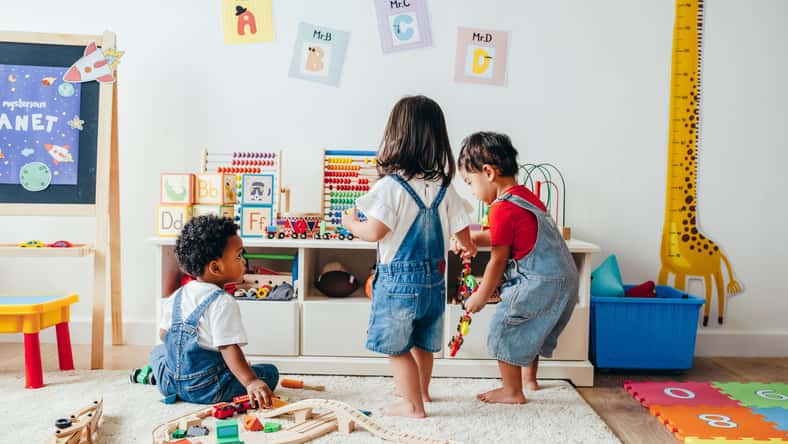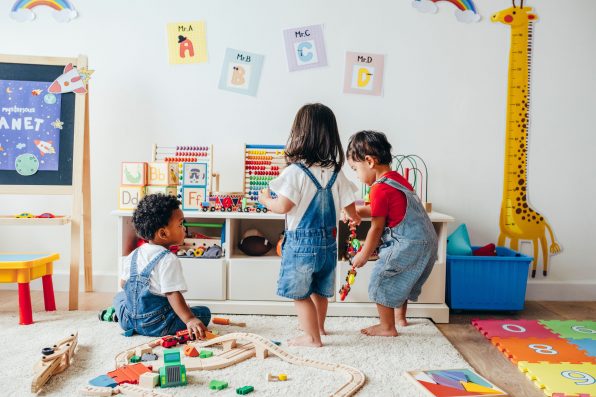A Toy Rotation System Can Keep Playtime Fresh And Fun While Preventing Your Kids From Getting Overwhelmed Or Bored With All Their Trinkets

By one year of age, your child has probably accumulated an impressive array of toys, ranging from building blocks and board books to musical instruments and stuffed animals. You may have purchased some of them on a whim, while others are gifts from various friends and relatives. Now, it feels like the toys are taking over.
People believe that having many toys will bring hours and hours of fun. However, the truth is that kids often become overwhelmed or bored by the vast amounts of toys. Establishing a toy rotation can make home organization more manageable and keep playtime fresh and fun for your tiny tot.
A toy rotation is a simple but effective strategy for dealing with too many toys. With toy rotation, you’re allowing your child to play with one group of toys at a time. Then, you switch out the toys later on. This ensures that everything gets played with and that your child has access to fewer toys at once, which will lead to better quality play. Here’s how you can implement a toy rotation in your home.
Gather All The Toys
After your child has gone to bed, gather all the toys together so you can see what you’re working with. It’s easier to sort through the pile when your kiddo isn’t butting in.
Make sure to look in every nook and cranny for stray toys. Everything needs to be taken into account so you can properly pare down the collection. You don’t need to include the comfort item they constantly carry around or sleep with.
Donate Or Throw Out Some Toys
Once the toys are all laid out in front of you, evaluate them with a critical eye to determine which ones are keepers and which ones need to be gone for good. Start tossing out toys that are obvious junk and serve no real purpose. Anything that’s broken or has missing pieces can go straight into the trash.
For toys that your little one has outgrown or no longer play with, donate them to charity or a family with younger kids. Also, observe how many multiples of the same items your child has. If you don’t think they need 30 toy cars since most of them are just sitting in the corner collecting dust, get rid of some of them.

Rawpixel.com – stock.adobe.com – illustrative purposes only, not the actual children
Divide Keepers Into Categories
Next, divide the remaining toys into several different categories. You can sort them however you want, but here are some common categories that make organization easier.
- Action-oriented toys: These toys, such as balls, tricycles, and frisbees, encourage your child to move around, targeting their gross motor skills.
- Arts and crafts: These might include crayons, coloring books, stickers, paint, and clay, facilitating creativity.
- Books
- Building toys: Things like stacking blocks/cups and Legos help with fine motor skills.
- Musical toys: Small pianos, drums, shakers, etc can fall under this category.
- Pretending toys: These toys target social and emotional development while allowing your child to expand their imagination. They include kitchen sets, stuffed animals, and costumes.
- Thinking toys: Games, puzzles, and shape sorters contribute to cognitive development.
Create Sets Of Toys
Compile sets of toys, including a toy from each category, and put each set into separate rotation boxes. You can create three to six sets. Think about how your child will play with the items and provide opportunities for creativity. Save yourself some trouble by keeping toys of the same character or theme together.
When you’re done curating each set, pack them into boxes and label them with quick descriptions so you can find things easily. Store them somewhere that’s out of your child’s sight. If you’re getting questions about where the other toys are, tell your child those toys are on vacation and will be returning soon.
Place In-Rotation Toys In Plain View
Set up an area where the toys that are in rotation are on display. Then, you can cycle out the toys with ease. You can rotate the toys however often you want. There are no established rules you have to follow when it comes to toy rotations. The key is to be flexible. For example, if your little one enjoys playing with a certain toy every day, there’s no reason to tuck it away.
Sign up for Chip Chick’s newsletter and get stories like this delivered to your inbox.
More About:Parenting